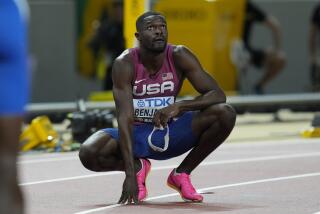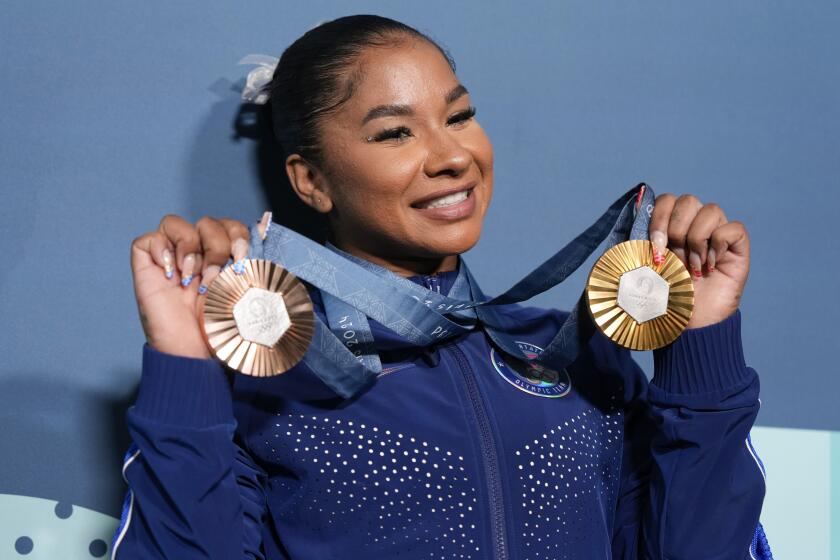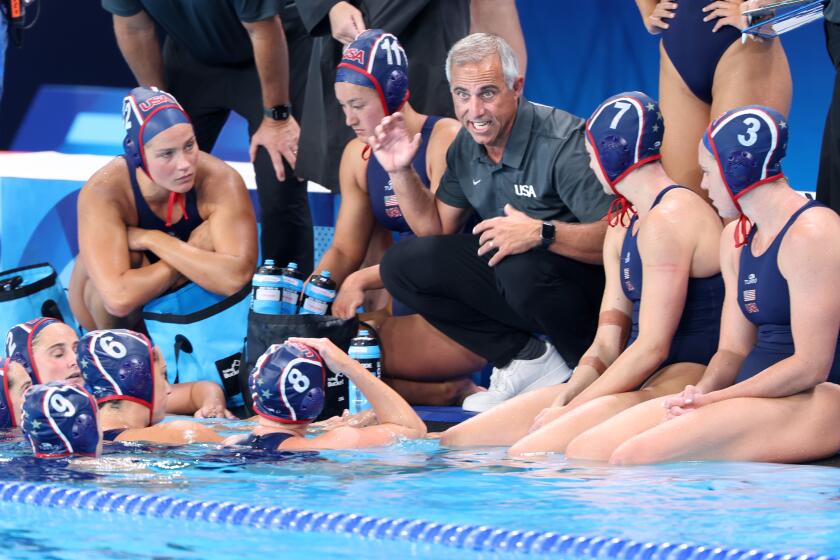Fire, ice -- and a lot of emotion
There were supposed to be eight athletes from the country of Georgia in the 21st Winter Olympics.
One is missing.
That left the Georgian delegation in Friday’s opening ceremony to wear black armbands as they mourned their missing teammate, Nodar Kumaritashvili, 21, who died in a horrifying crash during a luge training run barely eight hours earlier.
The athletes followed a flag with a black streamer carried by Alpine skier Iason Abramashvili.
The 60,600 people at BC Place stood to applaud their entry in a ceremony that became an often jarring mixture of celebration and grief.
Fireworks burst from the stadium floor to signal the start of the opening ceremony only seconds after the announcement, “Tonight’s ceremony is dedicated to the memory of Georgian Olympic athlete Nodar Kumaritashvili.”
“It’s like, oh, my God, the Olympics are so exciting, but at the same time, this person is supposed to be here with us,” said Israeli ice dancer Roman Zaretsky. “When we heard, it was devastating.”
The Georgian National Olympic Committee decided to let the team take part in the ceremony to honor Kumaritashvili’s expressed passion to experience what it meant to be an Olympian. The athletes almost immediately left the stadium after marching in, according to Canadian Television.
Winter Olympians from all countries, united in celebration and competition every four years, felt they had lost a member of their family.
“It’s definitely overwhelming, a roller coaster of emotions, I don’t know how to react,” U.S. bobsledder Steve Holcomb said.
Both International Olympic Committee President Jacques Rogge and Vancouver Organizing Committee Chief Executive John Furlong spoke of Kumaritashvili before the Olympic flame entered the stadium.
“May you carry his Olympic dream on your shoulders and compete with his spirit in your hearts,” Furlong said to the athletes.
There was a moment of silence for the Georgian luger after the singing of the Olympic hymn. A group of Canadian Mounties then lowered the Olympic and Canadian flags to half-staff.
In the can-you-top-this competition of Olympic caldron lightings, Vancouver cleverly blended fire and ice.
The caldron emerged from an ice-like floor in BC Place, as a projected image of the Olympic rings dissolved and the ice cracked.
Speed skating gold medalist Catriona LeMay Doan; basketball star Steve Nash, who grew up in British Columbia; Alpine ski gold medalist Nancy Greene, and the Great One, Wayne Gretzky, whose hockey team finished fourth in his lone Olympic appearance, were to light the bases of the caldron, sending fire up its metal legs until it created a central flame.
There was a major glitch, though, when one of the legs failed to rise, which left LeMay Doan standing idly by.
Speculation on who would light the stadium caldron ended in the decision to have the four Canadian sports icons do it together, after which Gretzky carried it from the stadium and climbed onto a pickup truck, taking it through the rainy streets to light an external caldron at Canada Place on the Vancouver waterfront.
Emphasizing the relationship Vancouver organizers have forged with aboriginal Canadians, on whose ancestral lands the Games are taking place, representatives of the Four Host First Nations and the aboriginal youth of Canada welcomed the world and the athletes to the Olympics after a jazzy -- and locally controversial -- rendition of “O Canada” by 16-year-old Montrealer Nikki Yanofsky.
With the sound system cranked up to deafening levels and the noise reverberating through the first domed stadium ever to host a Winter Olympic opening ceremony, the 48-minute parade of athletes from 82 nations was more enervating than entertaining.
The pure entertainment followed in a ceremony that cost about one-tenth of the $300 million China spent on its festivities at the 2008 Summer Olympics.
The cultural component tried to answer the questions of where Canada had come from, stands today and will be in the future. The answers, made in stunning visual effects and Cirque du Soleil-like high-wire acts, were pretty much drowned out by the loud soundtrack.
It was as if this vast and diverse nation, a nation long overshadowed by its neighbor to the south, needed to shout its separate identity to the world.
Who knew Canadians were Metallica at heart?
Heavy metal for heavy hearts?
It was a night of such discordant juxtaposition.
More to Read
Go beyond the scoreboard
Get the latest on L.A.'s teams in the daily Sports Report newsletter.
You may occasionally receive promotional content from the Los Angeles Times.




